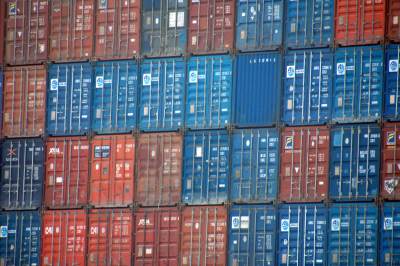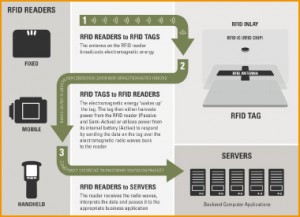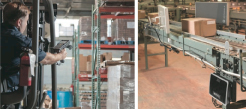We investigate how UHF-RFID is helping organizations across industries all over the world address critical business issues by automating product visibility and asset management processes
by Mark Wheeler, Motorola
 Margins and profitability are under more pressure than ever before. Shaving time out of business processes has become a constant quest — the ability to get more done in less time will ultimately reduce costs and strengthen the bottom line. Virtually every business spends an inordinate amount of time on the same initiative — obtaining the supply chain and asset visibility required to better manage the business. And no matter what industry you are in, chances are this effort is a tremendously time-consuming, manual and error-prone activity that slows down the speed at which your business operates — and adds to the cost of doing business. RFID is helping organizations across industries all over the world address these issues by automating product visibility and asset management processes. With the power of RFID, products and assets practically manage themselves, providing constant and effort free identification, location and tracking information.
Margins and profitability are under more pressure than ever before. Shaving time out of business processes has become a constant quest — the ability to get more done in less time will ultimately reduce costs and strengthen the bottom line. Virtually every business spends an inordinate amount of time on the same initiative — obtaining the supply chain and asset visibility required to better manage the business. And no matter what industry you are in, chances are this effort is a tremendously time-consuming, manual and error-prone activity that slows down the speed at which your business operates — and adds to the cost of doing business. RFID is helping organizations across industries all over the world address these issues by automating product visibility and asset management processes. With the power of RFID, products and assets practically manage themselves, providing constant and effort free identification, location and tracking information.
Radio Frequency Identification (RFID) is a champion at providing real-time inventory, supply chain and asset management visibility, all with little or no human intervention. The real-time visibility improves operations, stripping time and errors out of your everyday processes — from inventory, shipping and receiving logistics to intelligent asset management. And RFID is so versatile, you can find it at work in practically every industry, helping:
- distribution centers track shipments as they move in, out and through the warehouse
- retail stores perform more efficient cycle-counting and inventory operations
- hospitals ensure that all defibrillators and other critical equipment are in stock and in the right locations
- manufacturers ensure raw material availability and optimize sequencing processes
This affordable, near instant and constant visibility turns into big business benefits. Fewer errors, increased automation and a more efficient labor pool reduce costs and optimize business processes, allowing you to better serve more customers — increasing sales and profitability. How does it work? When RFID tags that contain a unique serialized EPC code are placed on items and assets, the information can be automatically, wirelessly and simultaneously captured with a fixed, handheld or mobile RFID reader. Hundreds of hours previously spent managing items are drastically reduced, yet you know where each and every item is, all the time — from inventory to returnable transport items (RTIs) to equipment, tools and back-up tapes.
Locationing technologies
There are a number of radio frequency technologies that are being used today to provide increased visibility into goods and assets. The most commonly used include:
- LF (Low Frequency)
- HF (High Frequency)
- UHF (Ultra High Frequency)
- Wi-Fi Locationing
- NFC (Near Field Communications)
- Ultra Wide Band (UWB)
… and others.
 Most of these utilize a defined band in the radio frequency spectrum that results in different operational and performance characteristics, which in turn affects read range, cost and deployment requirements. In addition, the technologies are not mutually exclusive. Depending upon your supply chain and asset visibility requirements, you may wish to deploy multiple RFID technologies. Read range can be extended in some of the technologies through the use of battery-assisted RFID tags. However, because of the battery cost, the longer read range comes with an increased cost per tag. As a result, battery assist technologies are typically utilized for higher-value items that warrant precise monitoring and locationing information. The frequency characteristics also define which applications are best suited for each technology. For example, NFC has become the defacto standard for ticketing and payment because of its short read range and established payment protocols. Alternatively, the long read ranges and low tag costs in the UHF frequency are ideal for inventory, supply chain and asset management visibility.
Most of these utilize a defined band in the radio frequency spectrum that results in different operational and performance characteristics, which in turn affects read range, cost and deployment requirements. In addition, the technologies are not mutually exclusive. Depending upon your supply chain and asset visibility requirements, you may wish to deploy multiple RFID technologies. Read range can be extended in some of the technologies through the use of battery-assisted RFID tags. However, because of the battery cost, the longer read range comes with an increased cost per tag. As a result, battery assist technologies are typically utilized for higher-value items that warrant precise monitoring and locationing information. The frequency characteristics also define which applications are best suited for each technology. For example, NFC has become the defacto standard for ticketing and payment because of its short read range and established payment protocols. Alternatively, the long read ranges and low tag costs in the UHF frequency are ideal for inventory, supply chain and asset management visibility.
 Today’s Gen 2 UHF RFID tags make RFID an affordable reality. Unlike active tags, these passive tags do not require their own power source — the reader provides the power to initiate the transmission of data. Since less technology is required in the tag, their cost is very low. A low cost RFID tag means you can tag and increase visibility into more of the goods, products and assets which drive your revenue stream. The tags can be re-used, easily updated with new data. And since these tags can be read from near contact to as far as 30+ feet away,1 you can use them on nearly any type of asset. The result is a rapid return on investment (ROI) in as little as six months to a year — even for the largest of organizations.
Today’s Gen 2 UHF RFID tags make RFID an affordable reality. Unlike active tags, these passive tags do not require their own power source — the reader provides the power to initiate the transmission of data. Since less technology is required in the tag, their cost is very low. A low cost RFID tag means you can tag and increase visibility into more of the goods, products and assets which drive your revenue stream. The tags can be re-used, easily updated with new data. And since these tags can be read from near contact to as far as 30+ feet away,1 you can use them on nearly any type of asset. The result is a rapid return on investment (ROI) in as little as six months to a year — even for the largest of organizations.
RFID in action
 UHF RFID brings value to virtually any business that has bulk items to manage — from product moving through the supply chain to inventory to equipment. In the following pages, you can see the benefits of UHF RFID solutions in industries including retail, distribution and warehousing, manufacturing, government, energy (utilities, oil and gas) and healthcare. Horizontal applications include asset management, IT asset management, returnable transport Items (RTIs), track and trace: cold chain/food safety.
UHF RFID brings value to virtually any business that has bulk items to manage — from product moving through the supply chain to inventory to equipment. In the following pages, you can see the benefits of UHF RFID solutions in industries including retail, distribution and warehousing, manufacturing, government, energy (utilities, oil and gas) and healthcare. Horizontal applications include asset management, IT asset management, returnable transport Items (RTIs), track and trace: cold chain/food safety.
Retail
 Retailers need detailed inventory information to keep the right items on the shelves of the store. But manual cycle counts are too costly to be performed frequently enough to provide current information. UHF RFID’s constant and accurate inventory information provides visibility into inventory levels, allowing retailers to make sure that customers find the products they want to purchase on the store shelves. And since the information is collected automatically, sales associates can spend more time with your customers — instead of managing inventory. Applications include inventory and cycle counting, receiving, replenishment, item locating, loss detection/prevention and demand forecasting. Benefits:
Retailers need detailed inventory information to keep the right items on the shelves of the store. But manual cycle counts are too costly to be performed frequently enough to provide current information. UHF RFID’s constant and accurate inventory information provides visibility into inventory levels, allowing retailers to make sure that customers find the products they want to purchase on the store shelves. And since the information is collected automatically, sales associates can spend more time with your customers — instead of managing inventory. Applications include inventory and cycle counting, receiving, replenishment, item locating, loss detection/prevention and demand forecasting. Benefits:
- achieve near 100% inventory accuracy2
- maintain real time inventory information — without any labor costs
- reduce out of stocks by as much as 80 percent2
- minimize markdowns
- reduce inventory carrying costs by as much as 59 percent2
- increase associate efficiency — associates are free to spend more time serving customers
- Increase sales by as much as 14 percent
Distribution and warehousing
In the distribution industry, profitability is tightly tied to how fast and accurately inventory moves in, through and out of the warehouse. With UHF RFID, warehouse workers have the visibility they need to process thousands or hundreds of thousands of items every day, as fast and accurately as possible.
Applications range from shipping and receiving, put-away and picking, cross-docking to returnable transport item (RTI) management and inventory.
Benefits:
- achieve near-100 percent order and shipping accuracy2
- process orders up to 40 percent faster2
- improve workforce efficiency — reduce labor costs up to 30+ percent2
- improve inventory turns
- automate advanced shipping notice (ASN) delivery and receipt
- improve customer and trading partner satisfaction by delivering the right items on time, every time
Manufacturing
For manufacturers, success hinges on the speed and accuracy of their manufacturing operations. UHF RFID provides instant and accurate tracking of information at every step inside the manufacturing plant, trimming wasted time and costs out of end-to-end manufacturing processes — from receipt of raw goods to RFID-enabling supply, sequencing, assembly and shipping of final product.
The net result is a leaner and more profitable manufacturing operation. Applications include end-to-end warehouse operations, quality assurance, line sequencing, raw material supply, E-Kanban/replenishment, Work-in-Process (WIP)/Just in time (JIT). Benefits:
- improve global inventory accuracy — from raw to finished goods
- improve product quality with increased automation of process and materials visibility
- increase shipping and receiving accuracy
Government
UHF RFID helps federal, state, local and municipal governments find ways to better manage budget cuts by improving visibility into more timely information as well as the location of assets and items in the supply chain. Access to instant and accurate information can help government agencies keep city infrastructure and military equipment in good working order; reach disaster victims faster; execute more timely and accurate building code and health inspections; and more. The result is the more efficient delivery of higher quality services, improving citizen safety and satisfaction.
Energy
In the energy industries, the cost of unplanned downtime can be devastating to profitability. UHF RFID provides the constant visibility into the location of everything required to keep production plants up and running.
Automatic and accurate tracking of everything from materials and equipment to onshore and offshore personnel as well as emissions and equipment maintenance schedules allows energy producers to increase plant uptime, better protect employees and reduce the cost of compliance with strict environmental and security regulations.
Healthcare
UHF RFID provides hospitals with a constant window into the location of medical equipment, medical supplies, critical documents and even patients — without any human effort. The result is a new level of efficiency and accuracy in every day processes that drives productivity, patient safety and care quality up — and costs down. Applications include asset tracking, inventory management, identity and access management,document and folder tracking, patient location tracking
Aviation
 In the airlines industry, a single incidence of lost or delayed luggage can mean the loss of a long time loyal customer as well as additional costs that pressure margins that are already razor thin. But UHF RFID-enabled luggage tags allow airlines to ensure that the right bag is placed on the right plane every time. In addition, the transportation industry is also using RFID to provide supply chain visibility and ensure maintenance and repair are performed properly and on time.
In the airlines industry, a single incidence of lost or delayed luggage can mean the loss of a long time loyal customer as well as additional costs that pressure margins that are already razor thin. But UHF RFID-enabled luggage tags allow airlines to ensure that the right bag is placed on the right plane every time. In addition, the transportation industry is also using RFID to provide supply chain visibility and ensure maintenance and repair are performed properly and on time.
